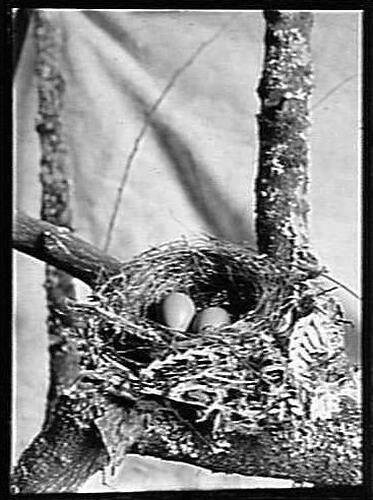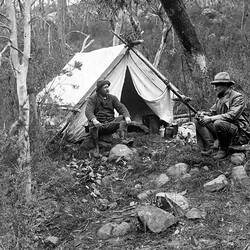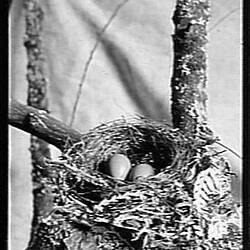WHITE-BREASTED ROBIN (Amaurodryas Gularis, Quoy & Gairmard - 177)
Geographical Distribution - West Australia.
Nest - Cup shaped; composed of strips of bark, fine twigs and leaves; in some instances decorated out-wardly with dead, bleached pieces of bracken fronds; lined inside with fine rootlets and grass. Usually placed low in the upright forked branches of a small tree (such as a Casuarina), in the fork of a grass-tree (Xanthorrhoa), or in a thick bush in forest. Dimensions over all, 3½ to 4 inches by 2½ inches in depth; egg cavity, 2 inches across by 1¼ inches deep.
Eggs - Clutch, two usually; inclined to oval in form; texture of shell fine; surface glossy; colour, olive or bronze-green, of a darker shade on or around the apex. Most resemble those of the Dusky or Hooded Robins. Dimensions in inches of a clutch: (1) .83 x .6, (2) .81 x .61; of another pair: (1) .86 x .61, (2) .83 x .59. (Plate 12).
Observations - The White-breasted Robin has a habitat peculiar to Western Australia, and may be easily identified by its dark, greyish coat, all under surface being white. Both sexes are alike in colour. To discover its nest and eggs was one of the tasks I set myself before leaving Melbourne for the great western territory. I had not been in the Albany district a week before I made my way to the Tor Bay saw-mills. There, to my delight, a pair of White-breasted Robins almost immediately introduced themselves by appearing about the men's quarters. In a day or two (2nd October, 1889) I was enabled to track them down to the creek close by, where, in a fork of an erect she-oak (Casuarina) sapling, eight or ten feet up, I discovered the nest containing a pair of eggs, about half-incubated. A few days or a week sub-sequently, in another part of the forest, I took a second nest, hidden in the fork of a grass-tree (Xanth-orrhoa), where the drooping, rush-like foliage carefully concealed the home. These eggs were perfectly fresh. A third nest, I found in a thick bush in the Karridale district, contained an addled egg.
Gould and other authorities class the Whit-bellied or White-breasted Robin with the Eopsaltria, and I have ventured to place it in the genus Amaurodryas, with the Dusky Robin of Tasmania, to which, oologically at all events, it more closely belongs. Probably the chief breeding months for the White-breasted Robin are from September to December.
Resources
Transcribed Archibald James Campbell. 'Nests and Eggs of Australian Birds, including the Geographical Distribution of the Species and Popular Observations Thereon', Pawson & Brailsford, Sheffield, England, 1900. pp.148-149.
More Information
-
Keywords
-
Authors
-
Contributors
-
Article types


